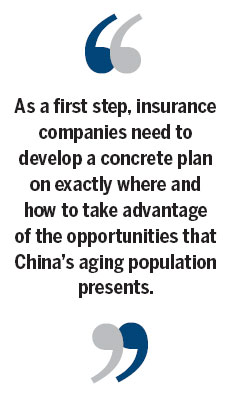In the silver wave, gold nuggets are to be found
Updated: 2012-07-06 12:25
By Christopher Kaye (China Daily)
|
|||||||||||

Insurance companies need to prepare as China's population ages
Insurance companies in China are facing extremely challenging times, but they are also facing a wealth of opportunities. A key element of both sets of circumstances is China's aging population.
To be sure, China has benefited from the so-called demographic dividend for decades. Its robust population structure has driven a prolonged period of socioeconomic growth. But as the workforce ages and moves toward retirement, the country will join many other nations in having to support a population that is more heavily skewed toward the elderly than before.
Indeed, by as early as 2015, China's working age population will begin to decline and the so-called silver segment of people aged 60 and above is projected to expand rapidly, from about 165 million in 2010 to as many as 440 million by 2050, representing more than a third of the country's total population.
These dynamics will put severe pressure on the social security system. The country's mandatory pension scheme will not keep pace with the rising cost of living, yet the market for voluntary pensions is still underdeveloped. In healthcare, the system is stymied by limited coverage and a lack of adequate resources, particularly regarding the long-term care that will become far more important as the country's population ages. In addition, mass country-to-city migration and the 4-2-1 (four grandparents, two parents, one child) family structure have led to a weakening of the traditional family support network.
Insurance companies will play a pivotal role in helping China deal with these challenges, which will have a significant impact on the country's prosperity level for decades to come. Failure to deal with the difficulties could have dramatic consequences, such as placing a heavy burden on public spending, delaying the retirement age and reducing benefits for retirees. If the worst were to occur, the country's social security net would rupture.
To prevent such dire consequences, the government will need to drive meaningful social security reforms, and corporations will have to take a greater initiative in providing post-retirement services. People will need to adopt a longer-term view on savings and investments. And insurers will have to actively engage with this agenda in order to keep their businesses viable and competitive. This will mean investing time and resources to build successful relationships with other stakeholders.
Specifically, insurers should focus on the five following imperatives:
Drive and support regulatory reform that will foster the development of complementary pension and healthcare insurance markets;
Collaborate with the social security system;
Develop deep consumer insights so that truly innovative products can be developed;
Consider investing in long-term care services;
Proactively manage for profits and risk (such as interest rates and longevity).
Overall, insurers need to position themselves to take advantage of the opportunity provided by nascent reforms that are encouraging private participation in pension and healthcare provision. Developing provincial and national lobbying strategies will be critical, as will educating consumers.
Insurers also need to focus more on product innovation and improving distribution channels, both to better address customer needs and to gain easier access to customers, either as individuals or through employers.
Building robust data bases to support accurate pricing of both medical and longevity risks will be another essential component of any successful strategy.
Obviously, insurers will be grappling with their own challenges. Some of these, such as workforce demographic risk, are similar to those that other industries will face. However, other hurdles, such as the expected prolonged period of low real interest rates, will have a direct impact on insurers' profitability.
Ultimately, insurers need to take swift action. China is rapidly approaching an inflection point where the ability to enjoy a demographic dividend will end, and the country will become far more centered on caring for the elderly, with all the implications for welfare costs and economic growth that entails. By 2030 China will have elderly population levels similar to those of most developed countries today. By 2050 it will have surpassed Japan.
As a first step, insurance companies need to develop a concrete plan on exactly where and how to take advantage of the opportunities that China's aging population presents. They need to start building the capabilities and relationships that will be required to win. And they need to put human resource strategies in place to manage the impact of demographic shifts on their own workforces.
Insurers that move quickly and boldly will be able to catch the wave that the silver segment represents, not only by delivering the products that China's aging population will need but also by being a positive force in the country's overall effort to cope with dramatic demographic changes. In so doing, for their own businesses, insurers can turn silver into gold.
The author is partner and managing director in the Boston Consulting Group's Hong Kong office. The views do not necessarily reflect those of China Daily.
(China Daily 07/06/2012 page11)
Today's Top News
Rescuers race against time for quake victims
Telecom workers restore links
Coal mine blast kills 18 in Jilin
Intl scholarship puts China on the map
More bird flu patients discharged
Gold loses sheen, but still a safe bet
US 'turns blind eye to human rights'
Telecom workers restore links
Hot Topics
Lunar probe , China growth forecasts, Emission rules get tougher, China seen through 'colored lens', International board,
Editor's Picks

|

|

|

|

|

|





